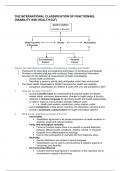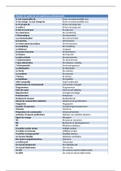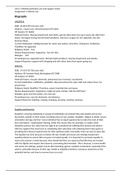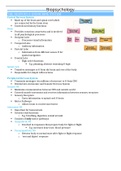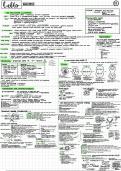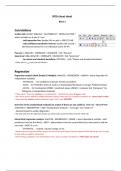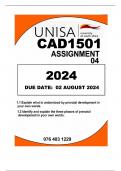ASSIGNMENT 50
2023
2023
GRADE R LESSONS - 1 WEEK
LESSON 1: MFP1501 - GRADE R (FACE-TO-FACE LESSON)
Learners in Grade R, already know how to solve real-life situations. Through story sums, use the learners’
situation to add and subtract numbers between one and ten. Carefully take note of the milestones you are
expected to cover by the time you are in school. Your mentor teacher will be of great assistance in your
planning of the lesson.
Your role as a teacher to introduce the story is very important to guide learners to resolve their addition and
subtraction concepts at the Grade R level and at the given number range.
Remember to use the lesson template provided for the purpose of structuring your lesson clearly
LESSON PLAN
LESSON 1:
Name and student Grade and date R
number
Content area Addition and Subject Mathematics
subtraction
Type of lesson Class lesson/group Theme of the week Fun with numbers!
work/
outdoor/fieldwork
Name of school Name of teacher
Outcomes Learners are able to:
Represent and solve addition word problems using objects.
Explain how to solve an addition word problem by acting with objects.
Concepts and new Story: something that has happened
knowledge of the Problem: something to be solved
lesson Equation: a math number sentence
Story problem: reading a text and asking questions about the numbers in it
Differentiation Enrichment: Invite learners to act out more complicated story problems. Ask
provided them to explain how to solve the problem with a partner and have them write
(enrichment/ learner down their steps and share out.
support/concerns) Support: Allow learners to count in their home language. Work with learners
,LESSON PRESENTATION
Introduction of lesson Gather the learners together for the start of the lesson.
Using objects, tell a story problem about the classroom. For example, "I have
three pencils, and you have two pencils, how many pencils do we have in all?"
Say, "In math we call this a story problem. Today we are going to practice
solving lots of story problems!"
Body of lesson Write up a standard addition equation such as 2 + 1 = 3. Review the definition
of an equation as a math number sentence. Review strategies learners might
use when solving addition equations (e.g., counting, drawing, and using a
number line).
Tell an additional story problem using objects.
Model how to solve the problem by counting the objects and use a number
line to show one strategy of keeping track of amounts when counting.
Show learners how to write a corresponding equation for the story problem
and practice reading the equation aloud.
Now, tell a story problem to the class, “I have six crayons and then I
found four more crayons in my desk. How many crayons do I have in all?”
Put the learners in pairs and provide each pair with a box of crayons.
Ask the learners to solve the problem in their group.
Gather back together and have learners share out how they solved the
problem. Highlight different strategies (e.g. moving the crayons, using a
number line, counting aloud, etc.).
Model how to use drawings to show the word problem on paper.
Write up the corresponding equation 6 + 4 = 10 and have learners practice
reading it aloud.
Explain that learners will now get to create their own story problem using
objects from the classroom using the steps below.
o Choose objects.
o Tell the story.
o Draw a picture to show the problem.
o Trade with your partner to solve solve the problem and write
an equation. Pair students together and then send them to
work.
Consolidation/ Gather learners together.
conclusion Tell the class a story problem.
Pass out worksheets and markers and have learners turn and talk to a partner
to solve the problem using their worksheets.
ASSESSMENT
1) Assessor Did the student involve the learners by asking a learner/s to repeat a Self-assessment
sentence, word or action? Yes Peer assessment
Teacher assessment
Pair learners to do or complete an action or activity Yes
Was there evidence of inclusion? Yes
2) Type of activity Participation – answering questions, reading activities, dialogue, role play
Written work (e.g. writing exercises, essays, making models, drawings, painting)
, Demonstrations (e.g. physical demonstrations, performing actions, experiments)
Models (e.g. collages, artwork, constructions)
3) Strategy/meth Questioning Writing Reading Reviewing
Listening Observation Interpreting Watching video
ods Listening
comprehension
4) Assessment Checklist Analytical rubric Other (give details)
Assessment scale Holistic rubric
Instrument
STUDENT SELF The lesson was successful.
REFLECTION
RESOURCES USED – Variety of classroom objects for story problems (books, toys, markers, crayons, cups,
ADD PAGES etc.)
Class set of white boards and markers
Number line
Unlined paper
TEACHER/MENTOR EVALUATION
How did you assist the student in planning of the lesson?
When did the student provide the completed lesson plan to you? (Before or after the lesson?)
Planning Question to be answered Not yet Almost Achieved Excellent
achieved achieved
1 2 3 4
Outcomes Were the outcomes achieved?
Concepts and Were concepts and new
new knowledge knowledge explained? Comments
of the lesson
Differentiation Were the types of questions
provided posed accommodative to learners
(enrichment/le with different learning abilities?
arner Comments
support/concer
ns)
LESSON PRESENTATION Not yet Almost Achieved Excellent
achieved achieved
1 2 3 4
Introduction of Was the introduction relevant?
lesson
Was the introduction interesting and
did it capture the learners'
attention?
, Was prior knowledge included?
Body of lesson Was the lesson content aligned
with the learning outcomes?
Comments
Were the activities appropriate for
the grade?
Was the lesson learner-centred?
Consolidation/ Did the student use
conclusion rhymes/poems/songs/listening
comprehension/an art activity or
any
other activity to consolidate
the lesson?
Was the lesson integrated with other
subjects?
ASSESSMENT
1) Assessor What type of assessment was used in the lesson? Self-assessment
Peer assessment
Teacher assessment
2) Type of Participation (answering questions, reading activities, dialogue, role play)
activity Written work (writing exercises, essays, making models, drawings, painting, etc)
Demonstrations (physical demonstrations, performing actions, experiments, etc)
Models (collages, artworks, constructions, etc.)
3) Strategy/ Questioning Writing Reading Reviewing
methods Listening Observation Interpreti Watchin
ng g a video
STRATEGY Not yet Almost Achieved Excellent
achieved achieved
1 2 3 4
Was it the most suitable strategy?
Were the learners actively involved?
4) Assessment Checklist Analytical rubric Other (give details)
instrument Assessment scale Holistic rubric
Were the assessment instruments used appropriately for the grade?
Was inclusivity visible in the use of these instruments?
MENTOR Teacher/mentor reflection:
REFLECTION
RESOURCES Not yet Almost Achieved Excellent
achieved achieved
1 2 3 4

